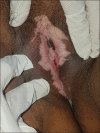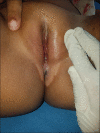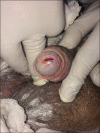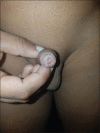Anogenital lichen sclerosus
- PMID: 33062974
- PMCID: PMC7529185
- DOI: 10.4103/ijstd.IJSTD_49_17
Anogenital lichen sclerosus
Abstract
Lichen sclerosus (LS) was first described by Hallopeau in 1887. It is a chronic inflammatory condition most commonly involving the anogenital region with a relapsing course and a potential for destruction, functional impairment, atrophy, and malignant changes. LS affects both sexes with a female preponderance of 5:1. The exact prevalence of the disease is difficult to predict as the lesions are asymptomatic in the initial phase and later when the complications arise patients might visit the surgeon, pediatrician, gynecologist, or urologist. The etiology of LS has a complex interplay of genetic factors, autoimmunity, infections, and trauma. Physical examination to assess the extent of the disease and decide the line of management is the most crucial step in the management. Corticosteroids, calcineurin inhibitor, retinoids, phototherapy, and surgery can be helpful. Self-examination and long-term follow-up are necessary.
Keywords: Balanitis xerotica; kraurosis vulvae; lichen sclerosus.
Copyright: © 2020 Indian Journal of Sexually Transmitted Diseases and AIDS.
Conflict of interest statement
There are no conflicts of interest.
Figures






References
-
- Friedrich EG. New nomenclature for vulvar disease. Obstet Gynecol. 1976;124:147–54. - PubMed
-
- Wallace HJ. Lichen sclerosus et atrophicus. Trans St Johns Hosp Dermatol Soc. 1971;57:9–30. - PubMed
-
- Cooper SM, Gao XH, Powell JJ, Wojnarowska F. Does treatment of vulvar lichen sclerosus influence its prognosis? Arch Dermatol. 2004;140:702–6. - PubMed
-
- Nelson DM, Peterson AC. Lichen sclerosus: Epidemiological distribution in an equal access health care system. J Urol. 2011;185:522–5. - PubMed
Publication types
LinkOut - more resources
Full Text Sources

